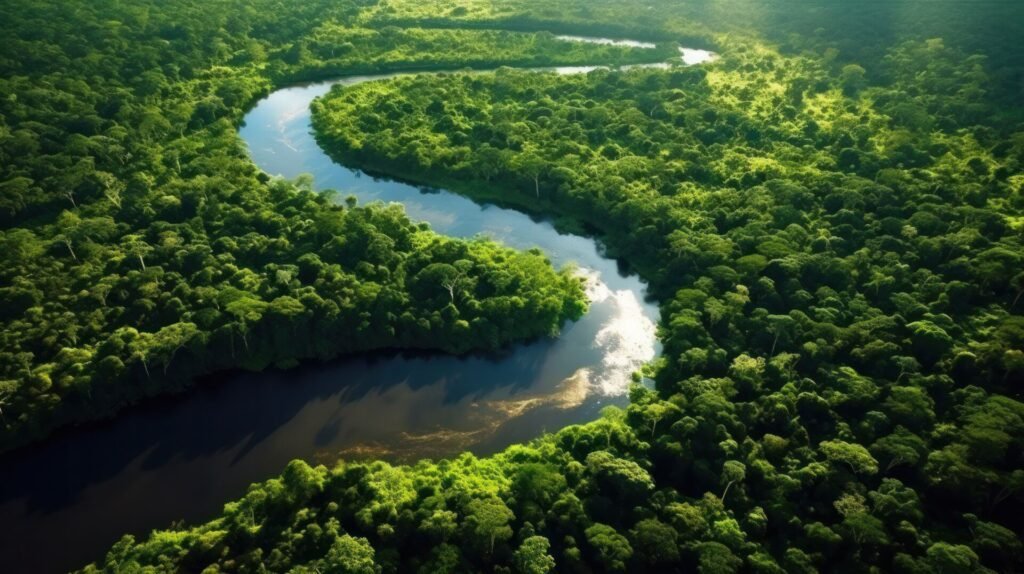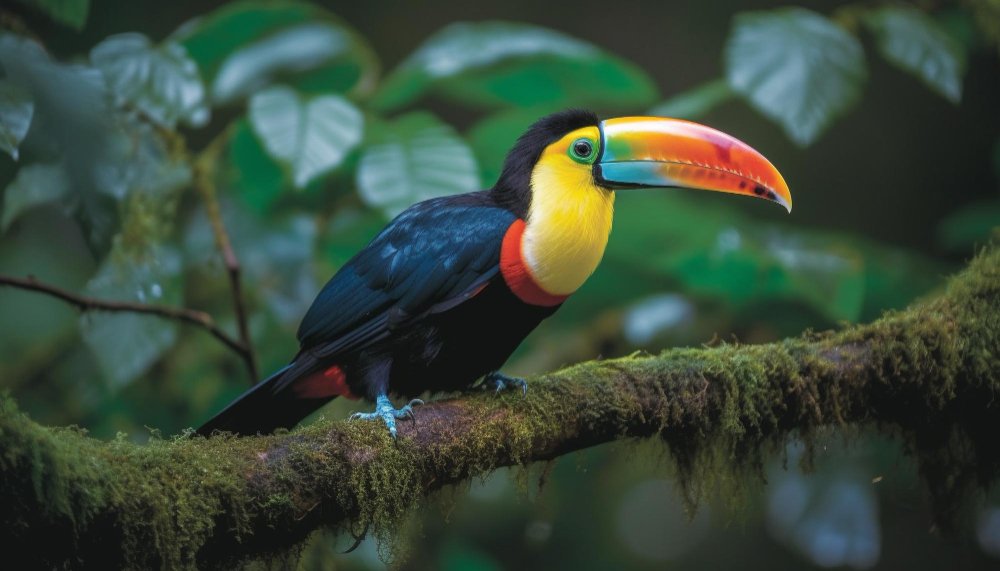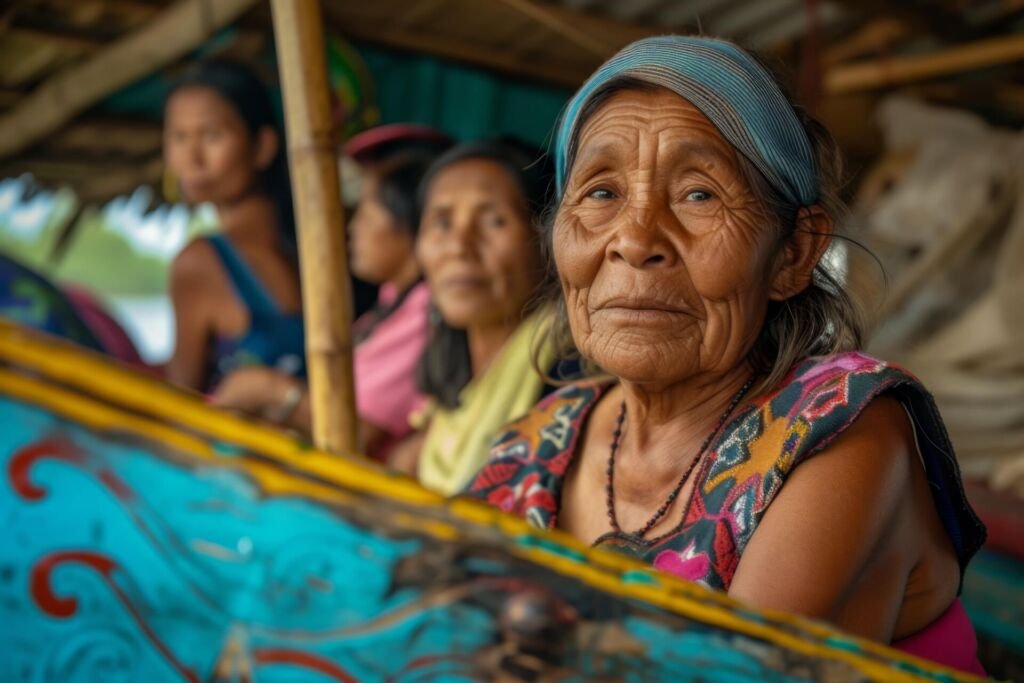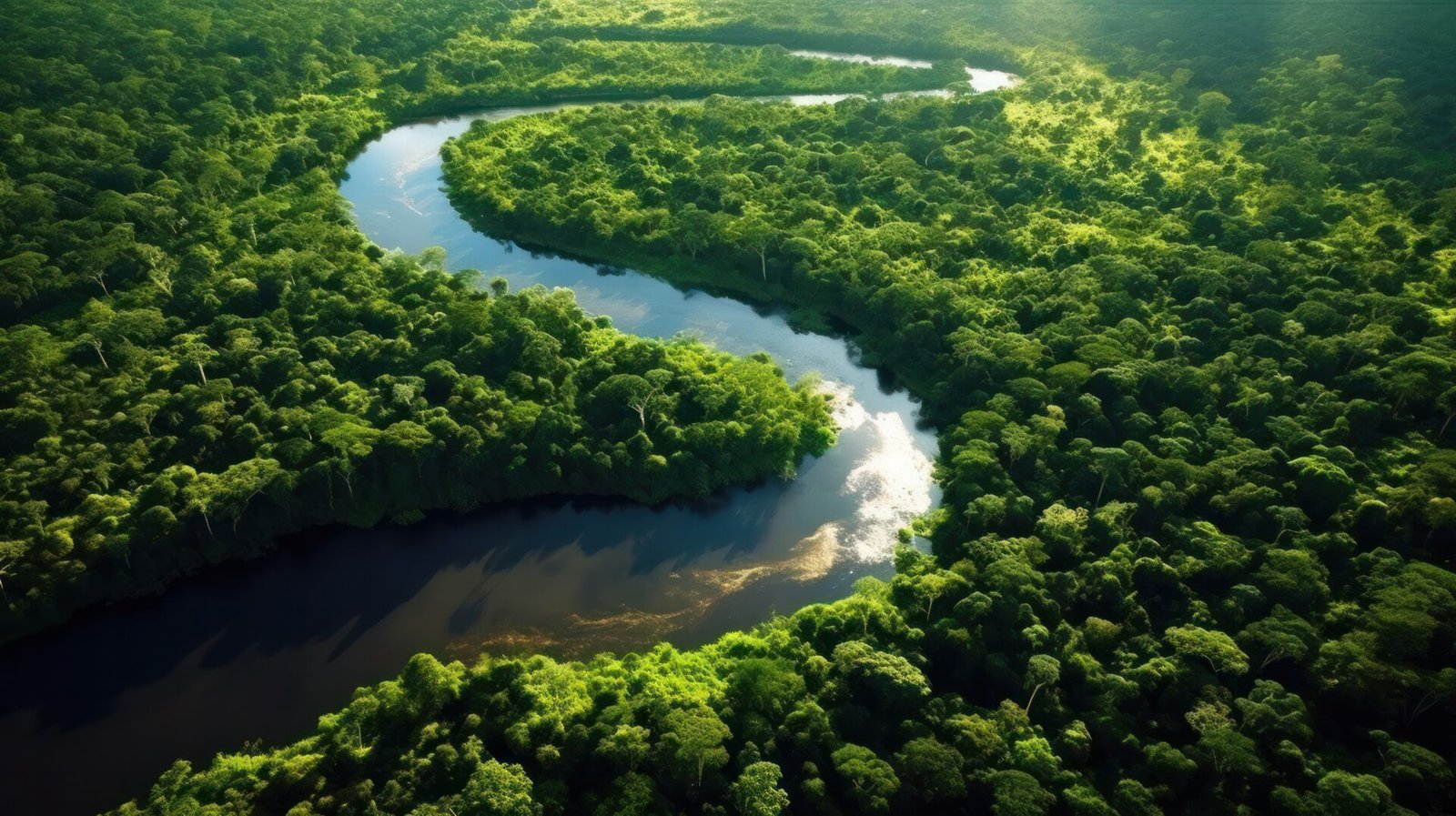Have you ever wondered how many different types of trees exist in a single acre of the Amazon rainforest? Or what percentage of the world’s oxygen it produces? Prepare to have your mind blown as we dive into the astonishing world of this incredible ecosystem.
⫸ Introduction to Amazon Rainforest
The Amazon rainforest is a realm of superlatives. It’s the planet’s green heart, where nature reigns supreme. Let’s delve into some fascinating facts about the Amazon rainforest that underscore its importance to our world.
The Heart of South America
The sprawling green giant’s Amazon rainforest blankets much of South America. Its sheer scale is awe-inspiring, and it is a vibrant tapestry of life woven across nations. This vast ecosystem isn’t just a rainforest; it’s a beating heart, pumping vitality into our planet.
Amazon Rainforest: The world's largest and most biodiverse rainforest

The Amazon boasts staggering numbers. It’s the world’s largest tropical rainforest, a haven for an estimated 10% of all known species on Earth! Imagine thousands of vibrant bird species, countless insects shimmering like jewels, and creatures so strange they defy categorization. This biodiversity is a treasure trove for scientists, a source of potential medicines, and a testament to the power of nature.
Its essential role in global climate regulation
Facts about the Amazon rainforest extend far beyond its borders. The Amazon breathes for the planet. Its trees absorb vast amounts of carbon dioxide, mitigating climate change. It acts as a giant water pump, influencing rainfall patterns across continents. The Amazon is not isolated; its health is intertwined with our own.
⫸The Amazon's Extraordinary Biodiversity:
The Amazon rainforest teems with an astounding array of life, making it one of the world’s most biodiverse ecosystems. This biodiversity is a key reason why the Amazon is so important for the health of our planet. Let’s explore some incredible plant and animal species that make this rainforest their home.
Amazon Rainforest Plants
● Diverse flora and their adaptations
The Amazon is home to an estimated 40,000 plant species! They’ve evolved fascinating adaptations to the rainforest’s unique conditions: tall buttress roots for stability, drip-tip leaves to shed excess rain, and the ability to climb to reach sunlight in the dense canopy.
● The vital role of plants in the rainforest ecosystem:
Amazon rainforest plants are the foundation of the ecosystem. They provide animal food and shelter, help regulate the climate, and produce much of the oxygen we breathe.
● Medicinal and economically important plants
Many rainforest plants have medicinal properties used by indigenous peoples for centuries. Others, like the Brazilian nut and rubber trees, are of global economic importance.
Amazon Rainforest Animals
● Incredible variety of mammals, birds, reptiles, amphibians, and insects
The Amazon is a haven for animals, with an estimated 430 mammal species, 1300 birds, 400+ amphibians, and a mind-boggling 2.5 million different insects! The diversity is astonishing, from jaguars and sloths to toucans and poison dart frogs.

● Unique creatures found only in the Amazon
Species like the pink river dolphin, the glass frog, and the vibrantly colored scarlet macaw exist nowhere else on Earth. These animals are a testament to the Amazon’s unique evolutionary processes.
● Animal adaptations to the rainforest environment
Amazon rainforest animals have amazing adaptations: Camouflage for predator and prey alike, powerful limbs for climbing, prehensile tails for grasping, and acute senses to navigate the dense rainforest.
⫸ The People of the Amazon:
The Amazon rainforest isn’t just a vibrant ecosystem; it’s home to a rich tapestry of human cultures that have shaped and been shaped by this unique environment. Let’s explore the diverse communities of the Amazon.
● Indigenous Communities
For thousands of years, the Amazon has been home to hundreds of indigenous tribes like the Yanomami, Kayapo, and countless others.

The rich cultural diversity of Amazonian tribes
Each tribe possesses its own unique language, traditions, and knowledge of the rainforest environment.
Sustainable living practices
Many indigenous communities of Amazon Rainforest live in harmony with the rainforest, practicing sustainable agriculture, hunting, and gathering that preserve its resources.
Challenges faced by indigenous groups
Sadly, deforestation, illegal mining, disease, and conflicts over land threaten the survival of many indigenous groups and their ways of life.
● Uncontacted tribes of the Amazon rainforest
Amazingly, there remain tribes within the Amazon with minimal or no contact with the outside world.
Estimated number and reasons for isolation
Experts believe there may be dozens of uncontacted tribes choosing isolation to protect themselves from exploitation and the diseases that outsiders can carry.
The debate on contact vs. protection of their territories
Should uncontacted tribes be left undisturbed, or are there instances where intervention is necessary? This ethical question sparks much debate.
⫸ The Amazon: Earth's Lungs and Climate Regulator
The Amazon rainforest isn’t just a beautiful wilderness – it plays a vital role in regulating our planet’s health. We often hear it called “Earth’s Lungs,” and there’s a good reason. Let’s dive into how the Amazon influences crucial cycles that keep our planet in balance.

● The Amazon's Role in the Carbon Cycle
Carbon absorption and storage
The Amazon rainforest acts like a giant carbon sink. Its billions of trees absorb vast amounts of carbon dioxide (CO2) from the atmosphere through photosynthesis. This carbon becomes locked away in the trees’ leaves, trunks, and roots, mitigating the greenhouse effect and slowing global warming.
Effects of deforestation on carbon release
Sadly, when the Amazon is burned or logged, this stored carbon is released back into the atmosphere as CO2. Deforestation is a double-edged sword: it stops the absorption of CO2 and adds to the problem.
● The Water Cycle and the Amazon's Influence
Rainfall patterns within the rainforest
The Amazon creates its own weather. Trees release enormous amounts of moisture into the air, fuelling constant rainfall within the rainforest. This self-sustaining system is vital for the ecosystem’s rich biodiversity.
"Flying Rivers" and their impact beyond the Amazon
The staggering amounts of moisture evaded from the Amazon don’t stay put. They form “flying rivers” – massive aerial flows of water vapor carrying rain far beyond the rainforest. These rivers are a lifeline for agriculture and populations across South America.
⫸ Environmental Challenges Facing the Amazon
The Amazon rainforest, a true world wonder, faces many environmental threats that jeopardize the Rainforest food web and its future. Understanding these challenges is crucial for appreciating the urgent need to protect this vital ecosystem.
● Deforestation
Deforestation is the single largest threat to the Amazon. Driven by forces like:
Major causes (cattle ranching, agriculture, logging)
- The conversion of forest to cattle pastures, soy plantations, and illegal logging operations destroys vast swaths of rainforest each year.
Devastating impact on biodiversity and climate
- Not only does deforestation cause direct habitat loss for countless Amazon rainforest animals and plants, but it also disrupts the delicate carbon balance of our planet.
● Climate Change Impacts
Climate change acts as both a cause and consequence of Amazon’s destruction:
Droughts, fires, and their consequences
- Rising temperatures and altered rainfall patterns make the rainforest more susceptible to devastating fires, particularly when combined with deforestation.
Disruption of delicate rainforest ecosystems
- This disrupts the intricate relationships between Amazon rainforest plants, animals, and their environment, threatening the survival of many species, potentially even those of uncontacted tribes of the Amazon rainforest who depend entirely on the forest’s health.
● Other Threats
Beyond deforestation and climate change, the Amazon faces additional perils:
Mining and pollution
Activities like illegal gold mining release toxic mercury and other pollutants into rainforest rivers, poisoning ecosystems and harming both human and animal populations.
⫸ Conservation Efforts and the Future
The Amazon rainforest isn’t just a source of fascinating facts – its survival is vital for the entire planet’s health. Thankfully, many initiatives and movements are dedicated to protecting this precious ecosystem and charting a sustainable future. Let’s explore some of the most important conservation efforts.
● Sustainable Initiatives
Sustainable initiatives seek to balance the Amazon’s ecological needs with economic development for local communities:
Protecting Indigenous Lands
Indigenous groups are Amazon’s best protectors, and they have deep knowledge of the forest. Supporting their land rights and traditional ways of life is crucial for conservation.
Promoting Sustainable Agriculture and Resource Use
Agroforestry (combining trees and crops) and responsible resource extraction can provide livelihoods without destroying the rainforest.
● Global Cooperation
The Amazon’s fate affects the entire world, requiring international collaboration:
International Efforts to Combat Deforestation
Agreements and funding mechanisms aim to reduce deforestation rates, often by helping nations transition to sustainable practices.
● The Importance of Individual Action
It’s easy to feel overwhelmed, but our everyday choices matter for the Amazon’s future:
How We Can All Support the Amazon Rainforest
Reducing meat consumption, avoiding products linked to deforestation, and supporting conservation organizations all make a difference.
⫸ Conclusion
● The future outlook for the Amazon
The Amazon rainforest faces an uncertain future. Rampant deforestation, the intensifying effects of climate change, and continued exploitation threaten the very heart of this ecosystem. Scientific models paint a grim picture—if we fail to curb these destructive trends, the Amazon could face irreversible changes far sooner than many realize.
● The Amazon's importance to the health of the planet
The Amazon isn’t simply a beautiful wilderness but a life support system for the entire planet. Its role in regulating global temperatures, storing carbon dioxide, and generating rainfall cannot be overstated. The loss of the Amazon would have devastating ripple effects worldwide.
● The urgency of protecting this precious ecosystem
The time to act is now. This isn’t about far-off problems—the consequences of Amazon destruction are already felt in extreme weather events, disruptions to food production, and biodiversity loss. The rainforest’s survival is intertwined with our own.
● A call to action to ensure its survival
Protecting the Amazon rainforest requires action on multiple fronts:
- Support Indigenous rights: Indigenous communities are essential stewards of the rainforest.
- Change consumption habits: Reduce demand for products that drive deforestation (beef, soy, etc.).
- Advocate for conservation policies: Demand government action and accountability.
- Support sustainable initiatives: Choose products and companies committed to responsible Amazon practices.
The Amazon rainforest is a gift, but it is not guaranteed. The choices we make today will determine its fate and, in turn, the health of our planet.

